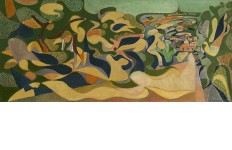Γλυπτική 15Σχέδιο 72Ελαιογραφία 74Τέμπερα 5Μικτή Τεχνική 30Υδατογραφία 15Χαρακτική 6Ακρυλικά 9Gouache 5Αυγοτέμπερα 2
Ειδικές Πληροφορίες για τον Καλλιτέχνη
TITΛΟΣ ΕΡΓΟΥΟ ΔΡΟΜΟΣ ΓΙΑ ΤΗΝ ΙΤΕΑ
ΔΙΑΣΤΑΣΕΙΣ ΕΡΓΟΥΎψος : 33
Πλάτος : 75.5
ΥΛΙΚΟ ΚΑΤΑΣΚΕΥΗΣΕλαιογραφία (Λάδι σε καμβά)
ΥΠΟΓΡΑΦΗ ΚΑΛΛΙΤΕΧΝΗΚάτω Δεξιά
ΧΡΟΝΟΛΟΓΗΣΗ01-01-1933
ΕΛΕΓΧΟΣ ΓΝΗΣΙΟΤΗΤΑΣΔεν έχει ελεγχθεί

Provenance:
Irmos Gallery, Thessaloniki.
Private collection.
Exhibited:
Athens, Atelier, May 1935, No 13.
Athens, National Gallery Alexander Soutzos Museum, May 1973, No 5.
Athens, To Trito Mati, May 1977.
Literature:
Fotis Yiofyllis, History of Neohellenic Art, Athens 1963, 2nd volume, p. 411 (referred with different title).
N. Petsalis-Diomidis, Hadjikyriakos-Ghika catalogue raisonne 1921-1940, Athens 1979, p. 172, No 114 (illustrated), p. 96 (referred).
D. Iliopoulou-Rogan, N. Hadjikyriakos-Ghika The Appolonian - The Dionysian, Benaki Museum, Athens 2006, p. 90, No 129 (illustrated).
Generally acknowledged as the artist who introduced modernism to Greece, Nikos Chatzikyriakos-Ghika drew his inspiration from ancient Mediterranean civilizations and Byzantine mosaics to early 20th century avant-garde trends, expressing a complex approach to the question of 'Greekness', the main aesthetic and ideological concern of his generation. As Ghika himself said, "my roots are not in the Renaissance but in (Greco-Roman) Pompeii where the contrast between light and shadow is infinitely greater. Such a 'Greek' code does not, I believe, contradict the pursuit of a visual conception that is valid universally." 1
In Road to Itea, an intensely dynamic landscape engulfing a dirt road leading to a distant hamlet, painted in Greece in 1933, Ghika is inspired by the rich heritage of his native land to reach a creative fusion of modernity and tradition. In his comprehensive account on the artist, N. Petsalis-Diomidis notes: "In his 1932-34 output, Ghika focused more on design and through it on perspective and plasticity of form. The main achievement of these works from his mature Parisian period is the harmonious compositional blending of mutually supported straight lines and curves. The angular element of many of his earlier paintings is downplayed, while the curves proliferate, retaining a virile robustness. From this point on curves progressively dominate, while straight lines virtually vanish. This is also evident in two paintings Ghika executed in Greece in 1933, namely Women Bathers in Cave and Road to Itea."2
Reviewing Ghika's 1934 showing at the 'Cahiers d'Art' in Paris, art historian J.P. Rycke made a remark that would be perfectly valid for Road to Itea, a painting first showed in Athens in 1935: "Ghika's paintings are distinguished by a joyous palette based on a warm spectrum of ochre and pastel tints. They demonstrate an osmosis with the natural environment of his native country and induce a feeling of sweetness, gaiety and spontaneity far removed from the austerity and the more cerebral manner of the western artists in the exhibition. We can already see emerging in Ghika's work the quality that would later give rise to this assessment by the German Helmut Grieshaber: Mediterranean feeling in a European intellect." 3
Reviewing Ghika's output from the early 1930s, former Director of the National Gallery in Athens D. Papastamos notes: "The movement of the leaves and the colours burning through the sun show a sensuous art, breaking away from all cerebral coldness and suggesting its Mediterranean character. An intense emotionalism derives from the free chromatic expression of Ghika's painting and generously distributes an overall lyrical tone together with a deeply emotional vibration." 4 In the same vein, J.P. Rycke notes: "Now, Ghika felt, was the moment to 'create Mediterranean painting.' The time had come to be true to himself and fashion an independent style in order to become an artist of real significance, as Le Corbusier, his great architect mentor declared jubilantly in a letter of 1933" 5 - the year Ghika produced his Road to Itea.
1. See H. Kambouridis - G. Levounis, Modern Greek Art-The 20th Century, Athens 1999, p.122 and A. Delivorrias, 'The French Period of Nikos Hadjikyriakos-Ghika' in Ghika and the Avant-Garde in Interwar Europe, Ephesus publ., Athens 2004, pp. 15-31.
2. N. Petsalis Diomidis, Ghika [in Greek], Athens 1979, p. 96.
3. J.P. Rycke, 'Greekness and Modernism' in Ghika and the Avant-Garde, p. 117, and letter from Helmut Grieshaber to Ghika, 28.12.1938 (Ghika Archives, Benaki Museum, Athens)
4. D. Papastamos, Painting 1930-1940, Astir Insurance Company publ., Athens 1981, p. 92.
5. Rycke, 'The Grand Laboratoire' in Ghika and the Avant-Garde, p. 97.